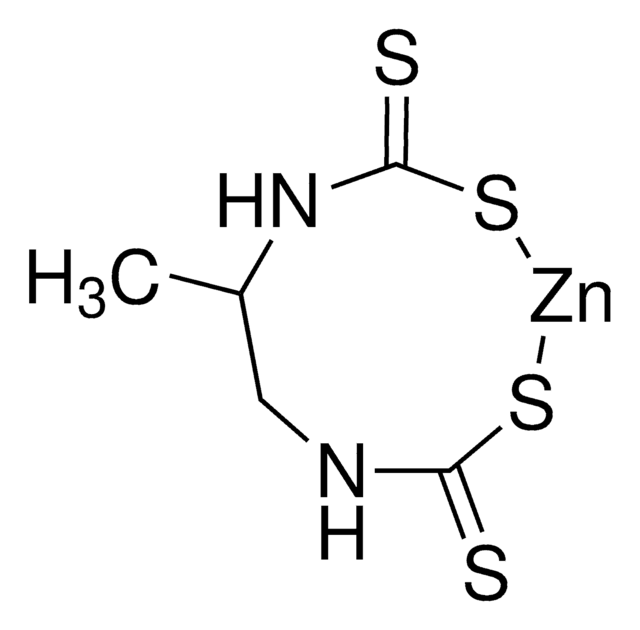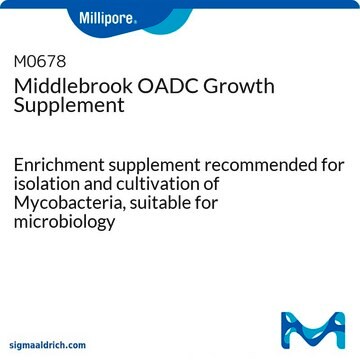49767
Glicerol
BioUltra, for molecular biology, anhydrous, ≥99.5% (GC)
Sinônimo(s):
1,2,3-propanotriol, Glicerina
About This Item
Produtos recomendados
grau
for molecular biology
Nível de qualidade
densidade de vapor
3.1 (vs air)
pressão de vapor
<1 mmHg ( 20 °C)
linha de produto
BioUltra
Ensaio
≥99.5% (GC)
forma
viscous liquid
temperatura de autoignição
698 °F
Impurezas
DNases, none detected
RNases, none detected
insoluble matter, passes filter test
phosphatases, none detected
proteases, none detected
resíduo de ignição
≤0.1%
índice de refração
n20/D 1.474 (lit.)
n20/D 1.474
pH
5.5-8 (25 °C, 5 M in H2O)
pb
182 °C/20 mmHg (lit.)
pf
20 °C (lit.)
solubilidade
H2O: 5 M at 20 °C, clear, colorless
densidade
1.25 g/mL (lit.)
traços de ânion
chloride (Cl-): ≤1 mg/kg
sulfate (SO42-): ≤10 mg/kg
traços de cátion
Ag: ≤5 mg/kg
Al: ≤1 mg/kg
As: ≤0.1 mg/kg
Ba: ≤1 mg/kg
Bi: ≤1 mg/kg
Ca: ≤5 mg/kg
Cd: ≤1 mg/kg
Co: ≤1 mg/kg
Cr: ≤1 mg/kg
Cu: ≤1 mg/kg
Fe: ≤1 mg/kg
K: ≤20 mg/kg
Li: ≤1 mg/kg
Mg: ≤1 mg/kg
Mn: ≤1 mg/kg
Mo: ≤1 mg/kg
NH4+: ≤5 mg/kg
Na: ≤20 mg/kg
Ni: ≤1 mg/kg
Pb: ≤1 mg/kg
Sr: ≤1 mg/kg
Tl: ≤5 mg/kg
Zn: ≤1 mg/kg
cadeia de caracteres SMILES
OCC(O)CO
λ
5 M in H2O
Absorção UV
λ: 260 nm Amax: 0.05
λ: 280 nm Amax: 0.07
InChI
1S/C3H8O3/c4-1-3(6)2-5/h3-6H,1-2H2
chave InChI
PEDCQBHIVMGVHV-UHFFFAOYSA-N
Procurando produtos similares? Visita Guia de comparação de produtos
Categorias relacionadas
Descrição geral
Aplicação
Ações bioquímicas/fisiológicas
- a supplement during cell culture of Mycobacterium tuberculosis and Mycobacterium avium.
- a fuel during designing enzymatic biofuel cell.
- a liquid composite matrix with 4-HCCA and 3-aminoquinoline for analysis of neutral and acidic glycans.
- a matrix for fast atom bombardment MS.
- may be employed as liquid matrix for the quantification studies by MALDI (Matrix-assisted laser desorption/ionization mass spectrometry) analysis.
Outras notas
Código de classe de armazenamento
10 - Combustible liquids
Classe de risco de água (WGK)
WGK 1
Ponto de fulgor (°F)
390.2 °F - Pensky-Martens closed cup
Ponto de fulgor (°C)
199 °C - Pensky-Martens closed cup
Equipamento de proteção individual
Eyeshields, Gloves
Certificados de análise (COA)
Busque Certificados de análise (COA) digitando o Número do Lote do produto. Os números de lote e remessa podem ser encontrados no rótulo de um produto após a palavra “Lot” ou “Batch”.
Já possui este produto?
Encontre a documentação dos produtos que você adquiriu recentemente na biblioteca de documentos.
Os clientes também visualizaram
Nossa equipe de cientistas tem experiência em todas as áreas de pesquisa, incluindo Life Sciences, ciência de materiais, síntese química, cromatografia, química analítica e muitas outras.
Entre em contato com a assistência técnica








